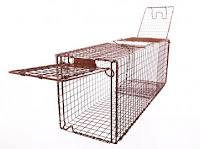Time and Patience
The most important tool at your disposal is time. Whether your tactic is to take a large number of traps and trap cats en masse or if you're only doing a few cats at a time, trapping consumes time. There will always be cats that do not go into the traps on their first encounter with them, even if the bait is temping. These cats require repeated attempts in order to be conditioned into trusting the traps. This may require watching cats you've already had fixed go in, eat, and exit a trap you have set while you watch and wait.
Traps
We currently have several different traps in our arsenal. Our favorite are our two TruCatch® 30-LTD (image on the left). These traps have two doors, one on each end, and each door operates with a different mechanism. This allows for more control and variety in the methods you may employ. The vet techs also appreciate the two doors.
We also use a Havahart® Large 1-Door Trap (image on the right). This trap is just as sturdy as the 30-LTD, but it only has one door, which makes it less versatile (Havahart does manufacture several 2 door traps, but this one was loaned to us by a neighbor). The door also utilizes a spring in its design that can wear out and is tricky to set. The 30-LTD has a chain which could potentially break, but the doors are locked shut by gravity instead of a spring. This method is safer for the cats too, as a spring-loaded door closing on a small cat could be fatal or at least cause injury. (They also hurt if they close on your arm by accident while you bait the trap.)
This is the drop-trap that we built and have had success with. The cats aren't nearly as skittish about going under this trap, but several cats can fit under it at once. We would never try to trap more than one cat per cage. That would be dangerous for us and the cats. It is constructed from PVC pipe and chicken wire. We built a door into the side to make transferring a cat from this trap to a cage much easier (cover trap with towel and put up against door, cat moves to safer looking dark space). Some large cats bang this trap around quite a bit during their initial freak-out and attempt to escape, the PVC makes it easy to add pea-gravel or sand to give it substantial weight (but can make it harder for the user to move around). It is useful to have a second person around while using this trap so one person can hold the trap down right after the catch while the other sets up the trap transfer.
Bait
Bait, as you can imagine, is a very important tool. We find that cheap, soft food provides strong enough encouragement that most cats get over their fear of going into the traps. A very cautious cat might watch the entire colony go in and out of a trap but still won't go in for regular dry food. The strong scent of moist food really brings them to the yard and attracts them to the traps. We have had even greater success microwaving the food to heat it up which makes even it stinkier. The first night we tried warming it, we saw three cats that we had never seen before come over to try the traps.
When a cat is trapped, it will freak out at first. We cover the cage with a towel to help, but they still thrash around quite a bit. We put the bait in small plastic dishes to try and avoid injury. Cleaning up cat blood from the floor as a result of a cut doesn't sound like a good time for anyone.
Kittens
 One of the most important methods for reducing the number of cats in a colony is catching them while they are young enough to be adopted out. Unfortunately, when young cats start venturing out from their "nest", they are already approaching an age when this is difficult, so time (the most important tool) is already against you. They are also at the bottom of the feeding totem pole. They may have to wait for every other cat in the colony to eat before they get their turn in the traps. To work around this, we made what we call a "Kitten Filter." This is simply a piece of coated, welded wire fencing that we cut to fit the trap door. Then we broke one of the welds to make a slightly larger hole. This is much too small for any full grown cat, but perfect for a young kitten.
One of the most important methods for reducing the number of cats in a colony is catching them while they are young enough to be adopted out. Unfortunately, when young cats start venturing out from their "nest", they are already approaching an age when this is difficult, so time (the most important tool) is already against you. They are also at the bottom of the feeding totem pole. They may have to wait for every other cat in the colony to eat before they get their turn in the traps. To work around this, we made what we call a "Kitten Filter." This is simply a piece of coated, welded wire fencing that we cut to fit the trap door. Then we broke one of the welds to make a slightly larger hole. This is much too small for any full grown cat, but perfect for a young kitten.
The drop trap can also be used for catching young cats by utilizing a short support stick. It will create a gap that is too small for adult cats to feel comfortable crawling under, but a kitten has no problem!




No comments:
Post a Comment